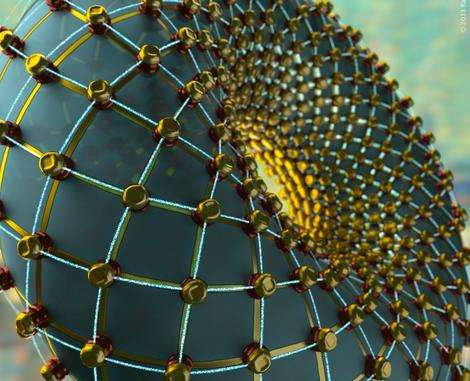Quantum cellmates with noisy networks

These components, called quantum bits, are fragile and susceptible to outside interference, making them easier to control when isolated in cells of four. Now scientists from Oxford and Singapore report in Nature Communications a way these cells could be networked up with light even if these links are 'noisy' and unreliable.
Pete Wilton at the Oxford Science Blog asked Simon Benjamin of Oxford University's Department of Materials and National University of Singapore, an author of the report, about quantum cells, noisy networks, and computing with pink diamonds…
OxSciBlog: What are the problems with conventional designs for a quantum computer?
Simon Benjamin: One way to build a quantum computer is similar to how today's microchips work: thousands or millions of basic components, all laid out in a dense pattern like buildings in a city. There are two problems with doing this:
First, the basic components of a quantum computer, called qubits, are hard to control and need to be kept as isolated as possible. Ideally you'd like to have each qubit in its own space with its own dedicated control systems around it.
The second problem is that some of the best candidate systems for qubits cannot be formed into ordered patterns, even if we want to. An example is something called an 'NV centre' which can occur naturally in diamond (technically it's a 'defect', but a very useful one!) Experimentalists can locate the NV centres in a piece of diamond and control them, but we can't force them to appear in specific places. Not yet anyway.
OSB: How might cells and a 'noisy network' overcome these problems?
SB: The approach we advocate is to replace that pattern of millions of qubits with many little chunks, or 'cells'. Each cell would only have a few qubits in it, for example four. It is a manageable task to control four qubits with a single set of control equipment, and most physical systems (like the NV centres mentioned above) can manage to store four qubits.
But of course this leaves us with a problem: how to link up the little cells? We know that linking quantum systems is possible using photons but sadly those links tend to be quite prone to errors. Fortunately we've found that it's ok to use those 'noisy' links: we can put up with them going wrong 10% of the time, or even more. And the qubits inside each cell can go wrong too, although they need to be better behaved, let's say they should go wrong less than 1% of the time.
The upshot of all this is that replacing the big, complex system with lots of little cells linked by noisy connections is fine - you don't really lose any performance, and the targets for how well behaved the qubits should be don't change much either.
OSB: What sort of systems might a noisy network work best with?
SB: Well I've already mentioned NV centres in diamond. The NV stands for Nitrogen-Vacancy, and this means that inside the diamond there is a place where a Nitrogen atom has replaced the normal Carbon, and beside this intruder atom there is a 'hole' where another Carbon is missing.
It turns out that this tiny structure has amazing properties: it can store several quantum bits, and they can be read out using a pulse of laser light. In fact, if you look at a diamond with a pink hue in a jewellery shop then the pink colour is typically coming from NV centres!
As well as NV centres, another good quantum system is the ion trap, where a few atoms are held frozen in a vacuum by an electromagnetic trap. It's hard to make a trap that can hold hundreds of atoms in an ordered way (let alone the millions that might be needed for computing). But it's not so hard to build many traps, each holding a few atoms, and link them with light.
OSB: What other types of 'noise' or 'error' does your approach not account for?
SB: In our study we've tried to be pretty general and put in all kinds of noise. Also, there are kinds of noise that we don't need to worry about because of the network architecture: something called 'correlated noise' can cause a lot of trouble, it means errors clumping together instead of appearing randomly. But in our system this shouldn't happen between different cells of the network, because they are far apart and disconnected except when we want them to communicate.
OSB: What does your work tell us about how hard it will be to build useful quantum computers?
SB: I would say that this work helps to show that the network approach (connecting lots of little computers) is very practical. Since some of the most promising candidate systems work well in the network picture, this is very encouraging.
One exciting recent result is that researchers in the Netherlands have just successfully shown a quantum link between two pieces of diamond, each inside its own fridge! So the idea of linking quantum systems definitely works... now we'll have to see how rapidly we can progress to a real network with lots of cells in it. A few years perhaps!
The paper, entitled 'Topological quantum computing with a very noisy network and local error rates approaching one percent', is published in Nature Communications.
More information: www.nature.com/ncomms/journal/ … full/ncomms2773.html
Journal information: Nature Communications
Provided by Oxford University

















